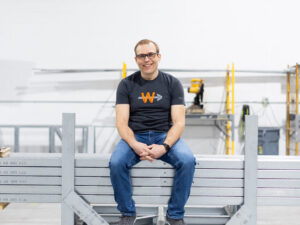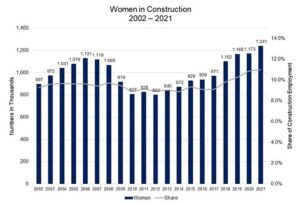The construction workforce “appears to be aging faster than it can recruit the next generation of workers,” says Larry Williams, executive director of the Steel Framing Industry Association (SFIA), in a recent Walls & Ceilings column.
“A lot of the well-known faces in the industry are about to change,” says Williams, who asks the question, “Who’s Next?” Who’s next to retire? he asks. But more importantly, who’s next in line to lead?
In recent months, the steel framing industry, and the construction industry at large, has seen a number of key executive retirements and announced retirements, which suggests the industry is undergoing a changing of the guard.
Are steel framing industry firms prepared? What should the next generation of leaders look like? Williams has ideas and urges the industry to see the opportunities and act.

The steel framing industry has “an opportunity to envision what the next generation of leaders should look like,” says Larry Williams, SFIA executive director.
“Too often, it seems, there has not been a lot of serious thinking about who will step up or step in when (insert name here) inevitably takes the career off ramp,” Williams writes in “Who’s Next?”
Envisioning the Next Generation of Leaders
The overall construction workforce is aging. Williams cites Bureau of Labor Statistics data showing the average age for a construction worker in the last 10 years has increased from 37.6 to 42.6 years — a gain of 5 years — while the average age of all workers grew not even one year. In other words, a young generation of workers has entered the workforce, but not so much in construction.
“This is about transformation, and the opportunity to think strategically about our industry’s next generations,” says Williams.
Since the 1990s, the cold-formed steel (CFS) framing industry “has been inundated with innovations to how framing is manufactured, fastened and connected, ordered, shipped and used to build structures,” Williams says. Technology is altering the planning, design and construction phases of projects, he says, and new building codes, energy codes and standards “have also been added to the mix.”

Dan Wies, president of Wies Drywall and Construction and an SFIA member, is part of a younger generation taking over the helms of long-standing construction firms.
Such changes have “transformed the industry from one centered around the traditional studs, screws and drywall,” Williams says, “to one where a good software package and technical tools are just as important as having a screw gun with the right RPMs.”
But further change lies ahead. It includes “products with more advanced performance at a lower cost” and the “further shrinking [of] our [steel framing industry’s] environmental footprint,” Williams says.
Industry change also includes “an opportunity to envision what the next generation of leaders should look like,” Williams says, “and to let go of the traditional image of the stereotypical ‘construction worker.’”
No More Stereotypical ‘Construction Worker’
Many future construction leaders will be women, Williams says. It’s a workforce group, he says, that has not been broadly invited to be a part of the construction industry.

The share of women in construction has lately ticked upward, but still represents a fraction of overall construction workers overall. Source: SFIA
According to the Current Population Survey (2022) sponsored by the United States Census Bureau and the U.S. Bureau of Labor Statistics, women comprised only 11% of the U.S. construction workforce. And most women in construction — 71% — hold sales and office jobs. Only 17% of women in construction are in management positions.
For the steel framing industry, this represents “a huge potential opportunity to address the labor shortage, while also creating the potential to improve productivity, efficiency and profit,” Williams says. In 2015, a McKinsey & Co. study found that companies with the greatest gender diversity outperform by 15% their competition in financial returns.
“While we [in the steel framing industry] are fortunate to have more and more extraordinary women in leadership positions,” Williams says, “there is more we can do to break the stereotypical male-dominated view of a career in construction.”
Williams recommends that construction industry firms:
- Better communicate career paths and career opportunities
- Offer benefits and incentives that appeal to women
- Provide mentoring and networking opportunities for both men and women
- Create opportunities for apprenticeships and real-life work experiences for both men and women
- Enforce a zero tolerance for workplace bad behaviors

OFFSITEK, an SFIA member, uses robots, cold-formed steel (CFS) and offsite manufacturing to construct affordable, high-quality, eco-friendly homes.
Growth of Tech and Digitized Processes
Williams says technology and digitized processes are becoming more pervasive in steel framing construction. Technology is introducing “a range of new potential leadership candidates with more diverse educational backgrounds and work experience,” he says.
“The traditional path to top leadership positions went through positions in finance, sales or operations,” Williams writes. “Today I believe that path should also include IT professionals, data analysts and mechanics that know as much about systems that rely on pneumatics and hydraulics as they do framing.”
In addition, the steel framing industry must prepare to recruit, retain and develop a younger leadership group — Generation Z. The members of Gen Z, born between 1997 and 2012, are 11 to 26 years old today.
“Gen Z members are amenable to pursuing training and education that doesn’t automatically include college,” Williams says.
“In fact, construction work — whose product is publicly visible for generations, crucial to people’s daily lives, and in the throes of R&D-driven technological reinvention — seems a perfect fit for this group interested in making a lasting contribution to society and the world,” he says.
Great societies plant trees under whose shade they shall never sit.
That Greek proverb says much about what steel framing industry firms need to do. The industry must act now and plant its own trees, Williams says, to ensure “the cold-formed steel framing industry stays on the path to greatness.”
Additional Resources
- 9 Ways Construction Firms Are Dealing with the Labor Shortage
- SFIA’s Williams Sees Robots Being a Staple in Future Steel Framing
- CFS Prefab 101: No Need for a Big Factory
